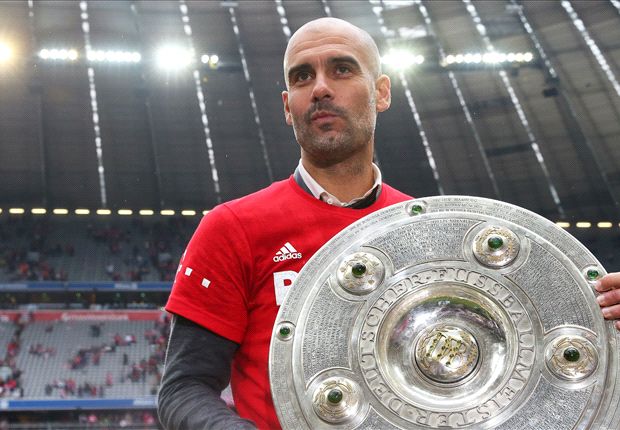Well, here we are. Another year gone and another Bayern title, this time they added in the Cup for good measure. Dortmund are (or were?) back to form, I predicted all four Champions League teams correctly, Stuttgart and Bendnter are gone, Wolfsburg tumbled down the table, Darmstadt and Ingolstadt stayed up, and ominously the malevolent force that is RB Leipzig is snorting, ready to be let out into the arena in the fall. While next year could be one of the more exciting Bundesliga seasons in recent times we have plenty of time to prepare for that later, let's dive in and try to more fully understand what just happened this year. We will start with team-level analysis and move on to player stuff in Part 2. Team Analysis Bayern and Darmstadt: Two Different Sports Champs once again. For a fuller dive into theirs and Dortmund's seasons, look at my winter break piece. Neither team made massive second half changes so much of that is still relevant. I track 30 metrics on a team level to scan to see what teams are trying interesting or unique things on the pitch. These are things like centrality, vertical build-up pass distance, deep completion %, etc, etc. Two teams constantly jumped off the map as straying far from the average: Bayern and Darmstadt. We start with the team who does not have Beard Guy: 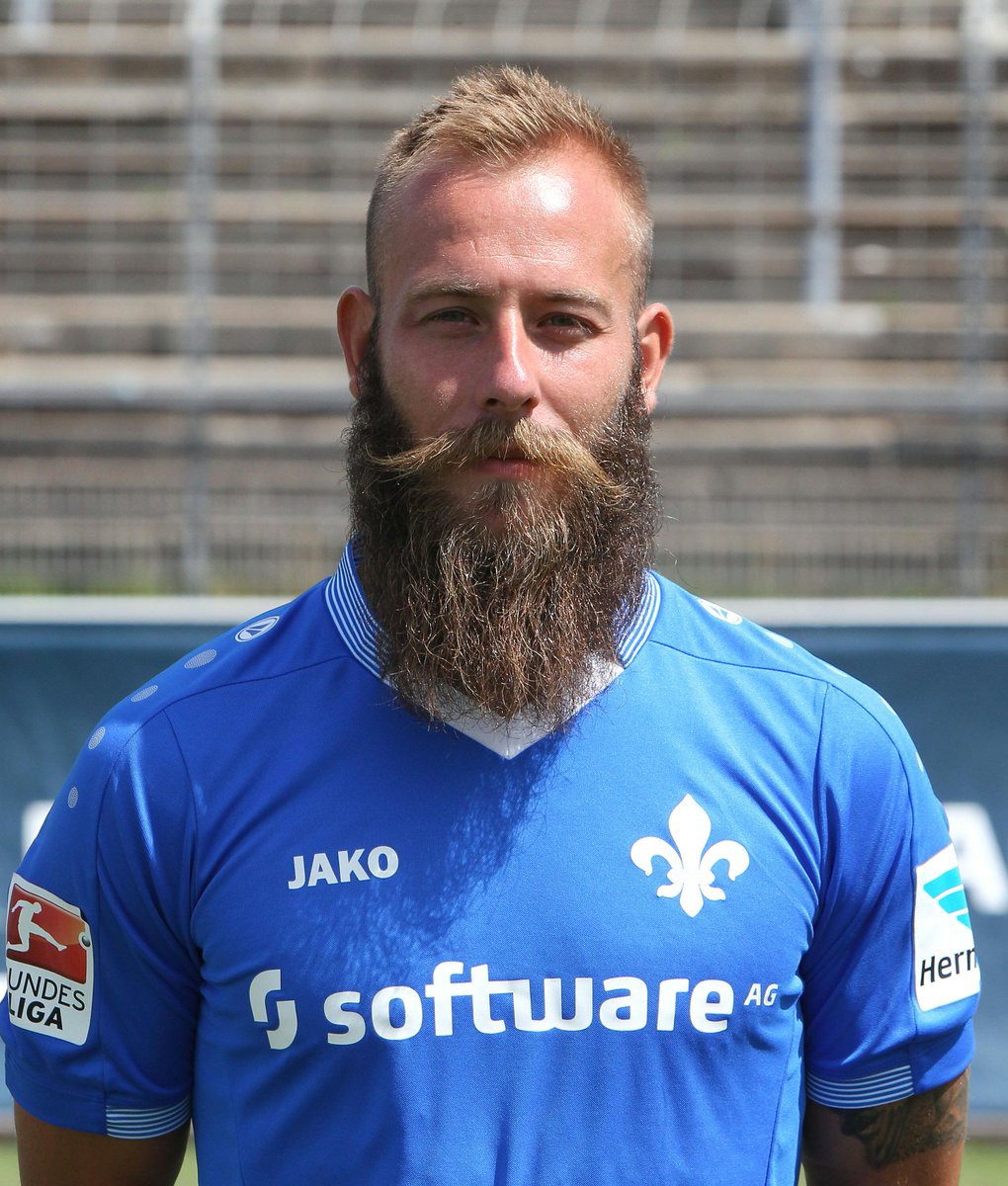
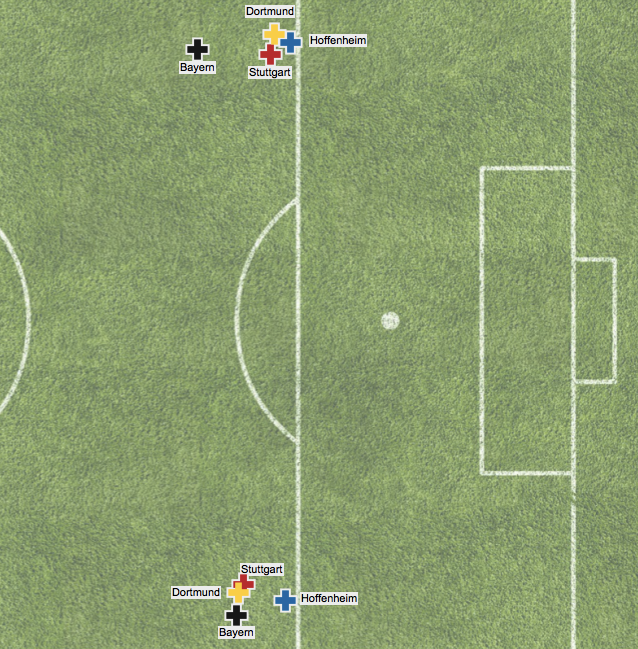 This may not look like much of a gap, but a pass toward goal from Hoffenheim’s average locations are about 20% more likely to be completed and *40%* more likely to be converted into a shot than passes originating from Bayern’s average locations without even factoring in Bayern’s typical numerical advantage where they force opponents into early passes toward isolated strikers. Seemingly small distances make a huge difference when it comes to around the goal. Other Superlatives Unsurprisingly Bayern were also outliers in holding opponents to a low deep completion % but impressively they also allow a lower proportion of total passes to even be played into dangerous positions (the “Atleti” stat). They also force opponents to play more vertically in their own half: the average team can spray the ball side to side comfortably in buildup, but Bayern completely erase that forcing you into looking straight ahead and shrinking the areas of the field that are available to pass into. You often wind up having to quickly play the ball through a tunnel to a harassed guy at the end of that tunnel. With the ball, they are the rare Bundesliga team that tries to "walk it in", playing much shorter vertical passes than the rest of the league. This and the fact they swarm the box (in the first part of the season no team got more men in the box for their shots than Bayern) obviously are great ingredients for high quality chances.
This may not look like much of a gap, but a pass toward goal from Hoffenheim’s average locations are about 20% more likely to be completed and *40%* more likely to be converted into a shot than passes originating from Bayern’s average locations without even factoring in Bayern’s typical numerical advantage where they force opponents into early passes toward isolated strikers. Seemingly small distances make a huge difference when it comes to around the goal. Other Superlatives Unsurprisingly Bayern were also outliers in holding opponents to a low deep completion % but impressively they also allow a lower proportion of total passes to even be played into dangerous positions (the “Atleti” stat). They also force opponents to play more vertically in their own half: the average team can spray the ball side to side comfortably in buildup, but Bayern completely erase that forcing you into looking straight ahead and shrinking the areas of the field that are available to pass into. You often wind up having to quickly play the ball through a tunnel to a harassed guy at the end of that tunnel. With the ball, they are the rare Bundesliga team that tries to "walk it in", playing much shorter vertical passes than the rest of the league. This and the fact they swarm the box (in the first part of the season no team got more men in the box for their shots than Bayern) obviously are great ingredients for high quality chances. 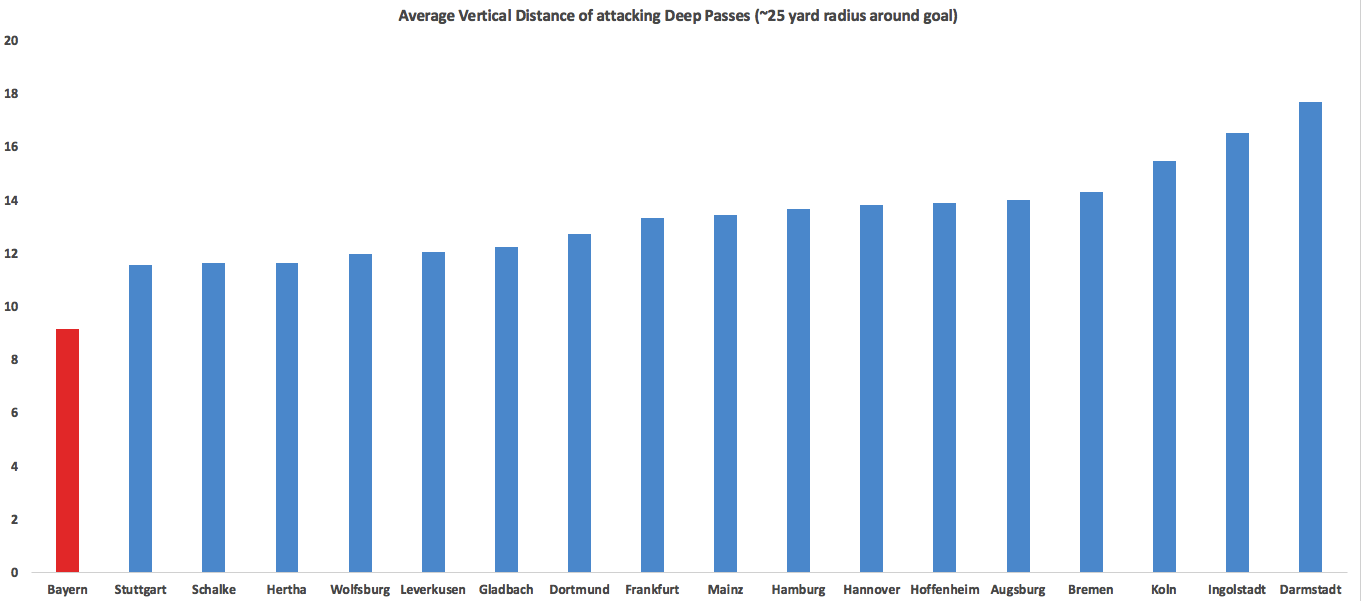 Getting past all the parts of their game and looking at the whole, Bayern as a whole this season were probably as close to a perfect team as we will ever see in the Bundesliga. Pep constantly increased their shots rate and territory dominance in his 3 years in charge and they had no real weaknesses. Dortmund had a team that could reasonably contend for any title in any league and the race was essentially over in early October when Bayern rolled them 5-1. For neutrals, the fact we didn’t get a two-legged, full-strength Barcelona vs Bayern matchup will be the biggest disappointment of Pep’s tenure. There can’t really be any substantive disappointments about the level they reached on the field. A non-stat moment that really resonated with me was Pep's final game. After winning in penalties, he was on the side crying for several minutes. The amount of effort and intensity Pep pours into each match and each season is really impressive and admirable and to see it kind of all come out with the final win and final title at Bayern was a nice way to cap an absolutely phenomenal 3 seasons. https://www.youtube.com/watch?v=siGFGn2pydo Darmstadt The other outlier team (the one with Beard Guy) played what looked to be a different sport. Darmstadt as you may have noticed were on the opposite end of Bayern on the previous chart. That happens a lot. They make Leicester and even West Brom look calm and measured as they essentially bombed the ball forward with no regard for human life. 67% of their midfield passes were played more than 3 yards forward, Bayern were at 41%. They built up like Bayern's opponents, never spraying the ball from side to side but just attacking vertically. Generally you don't want to play like Bayern's opponents but Darmstadt somehow made it work and scrapped to safety with a ragtag bunch of players and Sandro Wagner. The vertical pace they play at led to a league-low 16.9% of their shots being blocked and a ridiculous 8.3% of their completions coming within 25 yards of goal. That was nearly 3 standard deviations above league average:
Getting past all the parts of their game and looking at the whole, Bayern as a whole this season were probably as close to a perfect team as we will ever see in the Bundesliga. Pep constantly increased their shots rate and territory dominance in his 3 years in charge and they had no real weaknesses. Dortmund had a team that could reasonably contend for any title in any league and the race was essentially over in early October when Bayern rolled them 5-1. For neutrals, the fact we didn’t get a two-legged, full-strength Barcelona vs Bayern matchup will be the biggest disappointment of Pep’s tenure. There can’t really be any substantive disappointments about the level they reached on the field. A non-stat moment that really resonated with me was Pep's final game. After winning in penalties, he was on the side crying for several minutes. The amount of effort and intensity Pep pours into each match and each season is really impressive and admirable and to see it kind of all come out with the final win and final title at Bayern was a nice way to cap an absolutely phenomenal 3 seasons. https://www.youtube.com/watch?v=siGFGn2pydo Darmstadt The other outlier team (the one with Beard Guy) played what looked to be a different sport. Darmstadt as you may have noticed were on the opposite end of Bayern on the previous chart. That happens a lot. They make Leicester and even West Brom look calm and measured as they essentially bombed the ball forward with no regard for human life. 67% of their midfield passes were played more than 3 yards forward, Bayern were at 41%. They built up like Bayern's opponents, never spraying the ball from side to side but just attacking vertically. Generally you don't want to play like Bayern's opponents but Darmstadt somehow made it work and scrapped to safety with a ragtag bunch of players and Sandro Wagner. The vertical pace they play at led to a league-low 16.9% of their shots being blocked and a ridiculous 8.3% of their completions coming within 25 yards of goal. That was nearly 3 standard deviations above league average:  And still that's not even their craziest stat of the season. Last year across Europe, no team played a faster "pace" than Leverkusen, who took a shot every 17 completions. That was 2 standard deviations below the European average of 26. This year Darmstadt destroyed that by taking a shot every 13 completions. They are in a group of their own, with some room to stretch out.
And still that's not even their craziest stat of the season. Last year across Europe, no team played a faster "pace" than Leverkusen, who took a shot every 17 completions. That was 2 standard deviations below the European average of 26. This year Darmstadt destroyed that by taking a shot every 13 completions. They are in a group of their own, with some room to stretch out. 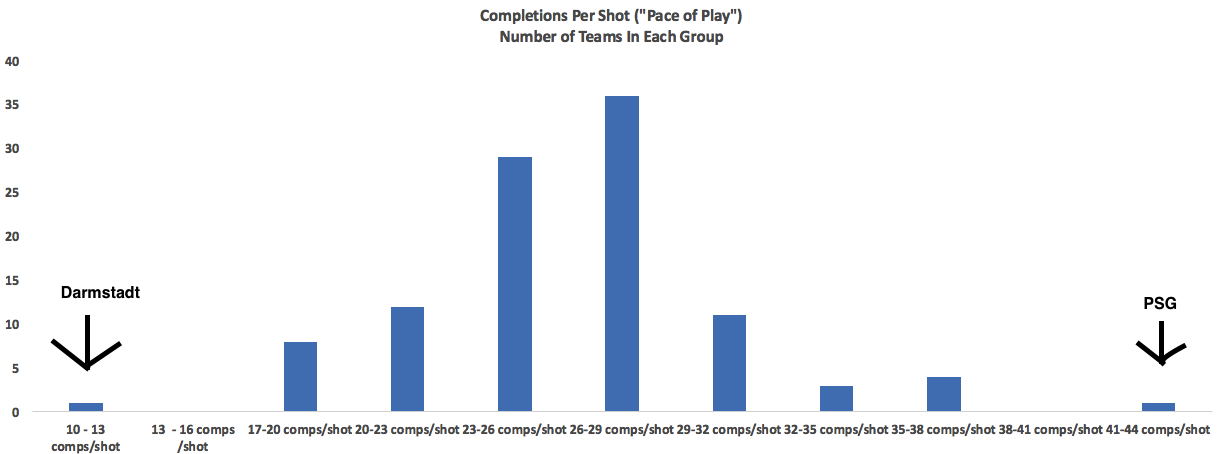 They weren't any good and should be heavy favorites for relegation next season but they are bad in a beautiful and unique way. Watching hundreds of games a year can sometimes get to be a slog (Frankfurt again?) so when we get teams like Darmstadt who are trying stuff so far outside the norm, I enjoy it. ***BONUS CONTENT*** The worst single shot quality game came in August when Hannover hosted Leverkusen. The average Hannover shot came from over 30 yards.
They weren't any good and should be heavy favorites for relegation next season but they are bad in a beautiful and unique way. Watching hundreds of games a year can sometimes get to be a slog (Frankfurt again?) so when we get teams like Darmstadt who are trying stuff so far outside the norm, I enjoy it. ***BONUS CONTENT*** The worst single shot quality game came in August when Hannover hosted Leverkusen. The average Hannover shot came from over 30 yards. 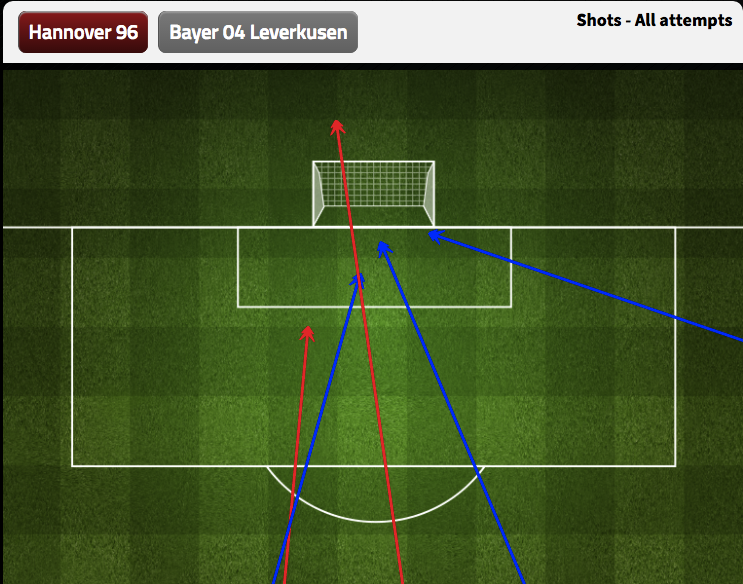 We should have known, if you can't get a shot to start on-screen at all in a home game, you might be headed for relegation. Dortmund Again more was written about them at the halfway mark in the link above, but they clearly re-established themselves as a legitimate top European team this season after last years strange bobble. Tuchel at Mainz showed a tendency to dominate the center of the pitch and he continued that this season and was able to narrow Dortmund’s previously too-wide dangerous passes:
We should have known, if you can't get a shot to start on-screen at all in a home game, you might be headed for relegation. Dortmund Again more was written about them at the halfway mark in the link above, but they clearly re-established themselves as a legitimate top European team this season after last years strange bobble. Tuchel at Mainz showed a tendency to dominate the center of the pitch and he continued that this season and was able to narrow Dortmund’s previously too-wide dangerous passes: 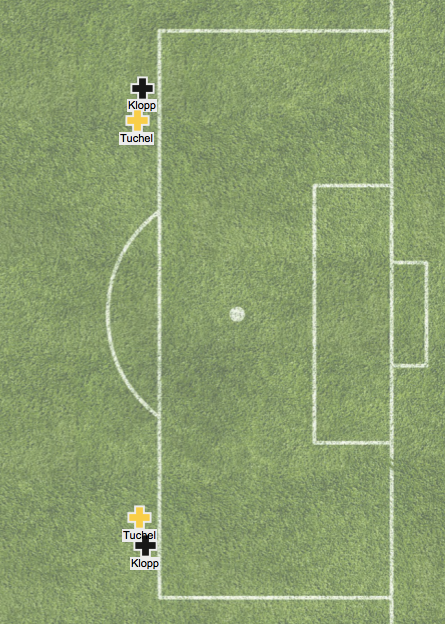
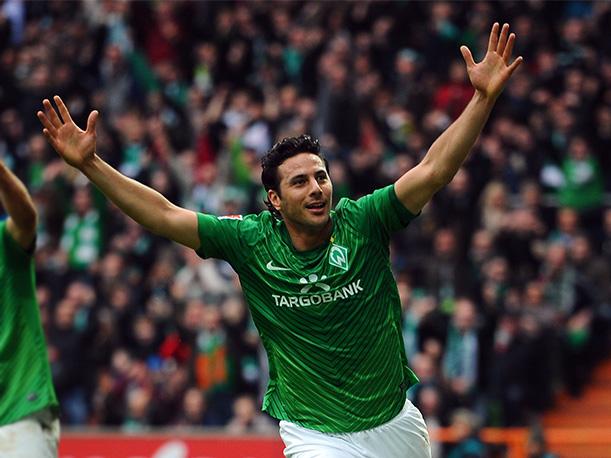 Werder Bremen This may seem strange at first as last year they finished 10th with 43 points and this season they slipped to 13th with 38 points with the exact same goals numbers (50 for-65 against) and battled relegation for a long time but bear with me. Let me make my case before you trust the table, which can have a Trumpian relationship with the underlying truth at times. No team improved as much as Bremen did from last year to this in increasing the number of passes they completed in dangerous areas. No team improved as much in decreasing the number of passes their opponents completed in dangerous areas. With these two improvements, they wound up pretty solidly on the positive side of the ledger here, and only behind the Big 3 when it comes to territory dominance.
Werder Bremen This may seem strange at first as last year they finished 10th with 43 points and this season they slipped to 13th with 38 points with the exact same goals numbers (50 for-65 against) and battled relegation for a long time but bear with me. Let me make my case before you trust the table, which can have a Trumpian relationship with the underlying truth at times. No team improved as much as Bremen did from last year to this in increasing the number of passes they completed in dangerous areas. No team improved as much in decreasing the number of passes their opponents completed in dangerous areas. With these two improvements, they wound up pretty solidly on the positive side of the ledger here, and only behind the Big 3 when it comes to territory dominance. 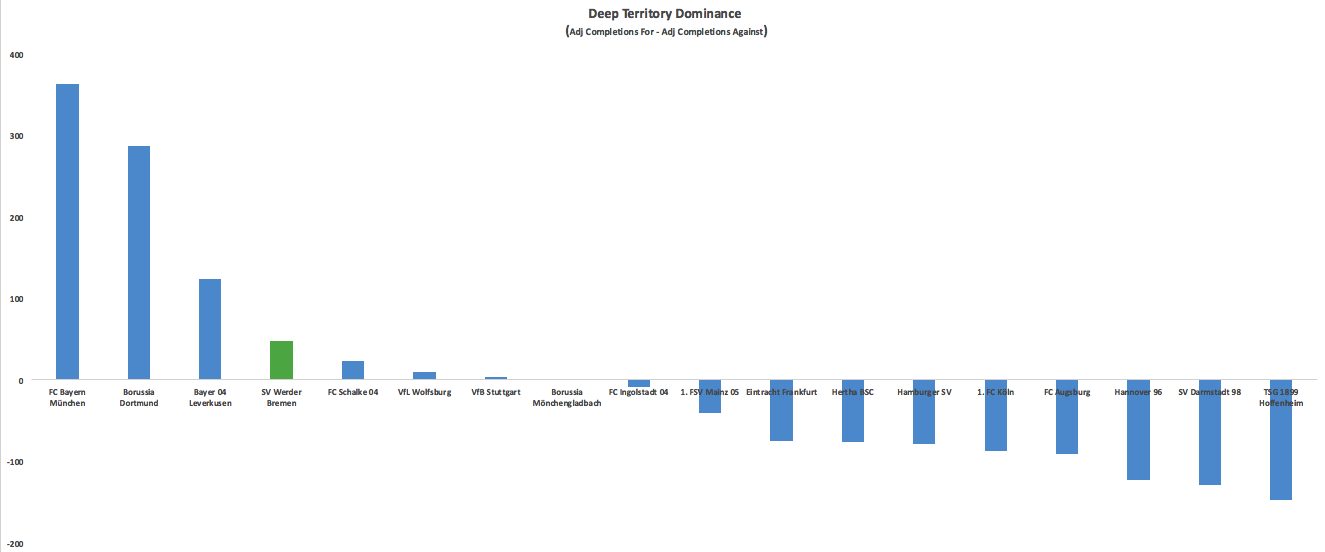 *Adjusted deep completions means I weight ones ending in a 0-15 yard radius from goal 4x as much as those from 16-30 and crosses are half as valuable as open play completions. Bremen were 7th in TSR, allowing a middling amount of shots (13 per game). There is reason to believe they might have been unlucky to allow that many: Bremen allowed a higher ratio of shots to deep completions allowed this year than any Bundesliga team over the past two seasons. This is something that seems to vary randomly (.15 R2 1st half to 2nd half and a similarly weak R2 year-to-year). Maybe former Chelsea star Papy Djilobodji is just completely ineffective at stopping shots but I suspect next season Bremen will see a significant drop in shots allowed. Even if they did have a hint of the Darmstadt forward rush about their build-up nowadays that doesn't have to be seen as a no-doubt terrible thing. The line between Darmstadt's silly looking anti-football and Leicester's exhilarating title-winning play is not a pretty thin one. Someone on twitter (I think it was @goalimpact but cannot find it now) once said Leicester are just Darmstadt with good players, and there is truth in that. Without running an analysis I would guess that Bremen would be one of the teams most closely related to Leicester in any sort of stylistic profile. Next year, Bremen should not have to sweat relegation. Extra Bremen note: Their shot distribution is a strange one, 10 players with >1000 minutes had between 0.9 and 2.6 shots/90 and different guys would be popping up to take shots in similar locations.
*Adjusted deep completions means I weight ones ending in a 0-15 yard radius from goal 4x as much as those from 16-30 and crosses are half as valuable as open play completions. Bremen were 7th in TSR, allowing a middling amount of shots (13 per game). There is reason to believe they might have been unlucky to allow that many: Bremen allowed a higher ratio of shots to deep completions allowed this year than any Bundesliga team over the past two seasons. This is something that seems to vary randomly (.15 R2 1st half to 2nd half and a similarly weak R2 year-to-year). Maybe former Chelsea star Papy Djilobodji is just completely ineffective at stopping shots but I suspect next season Bremen will see a significant drop in shots allowed. Even if they did have a hint of the Darmstadt forward rush about their build-up nowadays that doesn't have to be seen as a no-doubt terrible thing. The line between Darmstadt's silly looking anti-football and Leicester's exhilarating title-winning play is not a pretty thin one. Someone on twitter (I think it was @goalimpact but cannot find it now) once said Leicester are just Darmstadt with good players, and there is truth in that. Without running an analysis I would guess that Bremen would be one of the teams most closely related to Leicester in any sort of stylistic profile. Next year, Bremen should not have to sweat relegation. Extra Bremen note: Their shot distribution is a strange one, 10 players with >1000 minutes had between 0.9 and 2.6 shots/90 and different guys would be popping up to take shots in similar locations. 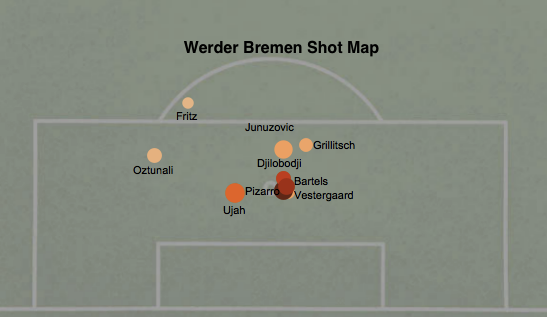 Honorable Mention: Schalke. Breitenreiter got their heads above water after the disastrous Di Matteo experiment but now they turn to Augsburg to take much lauded manager Marcus Weinzierl. I’ve never really been incredibly impressed with how Augsburg play and they’ve never stood out in the data, but it’s hard to tell what talent level he was working with. Schalke’s central midfield was basically a red carpet for teams to roll into attacking territory on, fix that and a Champions League return can be discussed. Others: Koln, Bayern (yes one of most improved teams after one of the best Bundesliga seasons ever last year), Hertha Berlin Most Disappointing Leverkusen
Honorable Mention: Schalke. Breitenreiter got their heads above water after the disastrous Di Matteo experiment but now they turn to Augsburg to take much lauded manager Marcus Weinzierl. I’ve never really been incredibly impressed with how Augsburg play and they’ve never stood out in the data, but it’s hard to tell what talent level he was working with. Schalke’s central midfield was basically a red carpet for teams to roll into attacking territory on, fix that and a Champions League return can be discussed. Others: Koln, Bayern (yes one of most improved teams after one of the best Bundesliga seasons ever last year), Hertha Berlin Most Disappointing Leverkusen 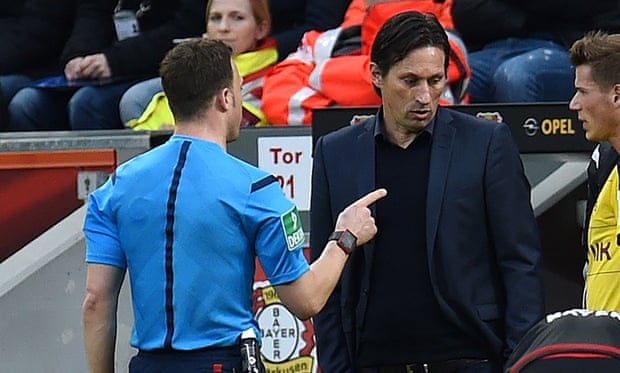 Roger Schmidt’s Leverkusen remain one of the most fascinating teams in Europe, but this season saw their progress slow and even start to drift backwards even as the potential for something great dimmed slightly. First, the potential. Their games against Barcelona and Bayern showed just how brutal to play against Leverkusen can be. In a messy home 0-0 draw, Leverkusen held Bayern to 9 shots and 77% passing, both near the bottom of the entire Pep tenure. At the Camp Nou, Barcelona had just 5 shots in the first hour and Leverkusen controlled the game before Barca got 2 late goals for a comeback win. Aside from the raw numbers, watching the games you really felt like these were just even teams going at it, in the Barca game I thought Leverkusen were the better team for most of the first half and pretty dominant at times. It's stretches like that and their powerful (though a little less powerful this season) pressing game that make you think there is Atletico Madrid-type potential here. One fantastic bit of information I love to pull out every time I talk Leverkusen is their sideline pressing trigger:
Roger Schmidt’s Leverkusen remain one of the most fascinating teams in Europe, but this season saw their progress slow and even start to drift backwards even as the potential for something great dimmed slightly. First, the potential. Their games against Barcelona and Bayern showed just how brutal to play against Leverkusen can be. In a messy home 0-0 draw, Leverkusen held Bayern to 9 shots and 77% passing, both near the bottom of the entire Pep tenure. At the Camp Nou, Barcelona had just 5 shots in the first hour and Leverkusen controlled the game before Barca got 2 late goals for a comeback win. Aside from the raw numbers, watching the games you really felt like these were just even teams going at it, in the Barca game I thought Leverkusen were the better team for most of the first half and pretty dominant at times. It's stretches like that and their powerful (though a little less powerful this season) pressing game that make you think there is Atletico Madrid-type potential here. One fantastic bit of information I love to pull out every time I talk Leverkusen is their sideline pressing trigger: 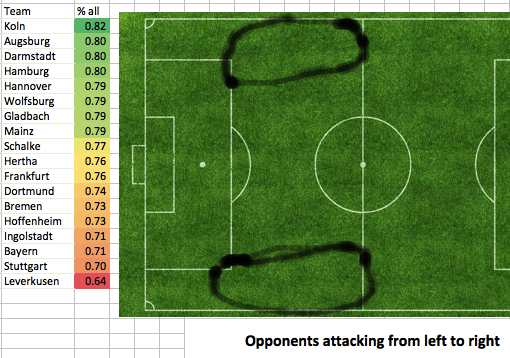 I first found that playing around with data and then later saw an interview where Karim Bellarabi said they are set-up to force opponents into these zones and then pounce to win the ball back. Pressing triggers and a few great performances aside, the big picture stats all trended the wrong way this season:
I first found that playing around with data and then later saw an interview where Karim Bellarabi said they are set-up to force opponents into these zones and then pounce to win the ball back. Pressing triggers and a few great performances aside, the big picture stats all trended the wrong way this season:  The one thing holding them back from making the leap into the elite teams in Europe has always been generating enough offense. The frenetic defensive style often seemed to seep over into their attack and they became careless with the ball leading to very few sustained possessions. This year they eased up on the helter-skelter ball a little bit: they took 23 completions for every shot, which was 5th quickest tempo in the Bundesliga after they were fastest in Europe last season at 17 completions per shot. They saw their midfield completion percentage rise 6 points (helped by a huge reduction in share of midfield passes being played forward). This increased tranquility didn’t transfer to improved offense, as we saw from the raw numbers, and it didn’t lead to a more efficient attack: a lower % of dangerous passes were completed. I’d always said there is no reason to play with the ball like they did without, but maybe there is some connection I've been missing as when Leverkusen dropped a bit of franticness with the ball, the intensity on D dropped a bit as well. Last year they forced opponents into 32 yard passes on average as they approached goal, nearly 3 standard deviations above the Bundesliga average and the longest in Europe. This year they weren’t even 1 SD above the league average at about 29 yards. Allowing shorter passes led to a dramatically higher success rate as you can see by the 2 seasons charted:
The one thing holding them back from making the leap into the elite teams in Europe has always been generating enough offense. The frenetic defensive style often seemed to seep over into their attack and they became careless with the ball leading to very few sustained possessions. This year they eased up on the helter-skelter ball a little bit: they took 23 completions for every shot, which was 5th quickest tempo in the Bundesliga after they were fastest in Europe last season at 17 completions per shot. They saw their midfield completion percentage rise 6 points (helped by a huge reduction in share of midfield passes being played forward). This increased tranquility didn’t transfer to improved offense, as we saw from the raw numbers, and it didn’t lead to a more efficient attack: a lower % of dangerous passes were completed. I’d always said there is no reason to play with the ball like they did without, but maybe there is some connection I've been missing as when Leverkusen dropped a bit of franticness with the ball, the intensity on D dropped a bit as well. Last year they forced opponents into 32 yard passes on average as they approached goal, nearly 3 standard deviations above the Bundesliga average and the longest in Europe. This year they weren’t even 1 SD above the league average at about 29 yards. Allowing shorter passes led to a dramatically higher success rate as you can see by the 2 seasons charted: 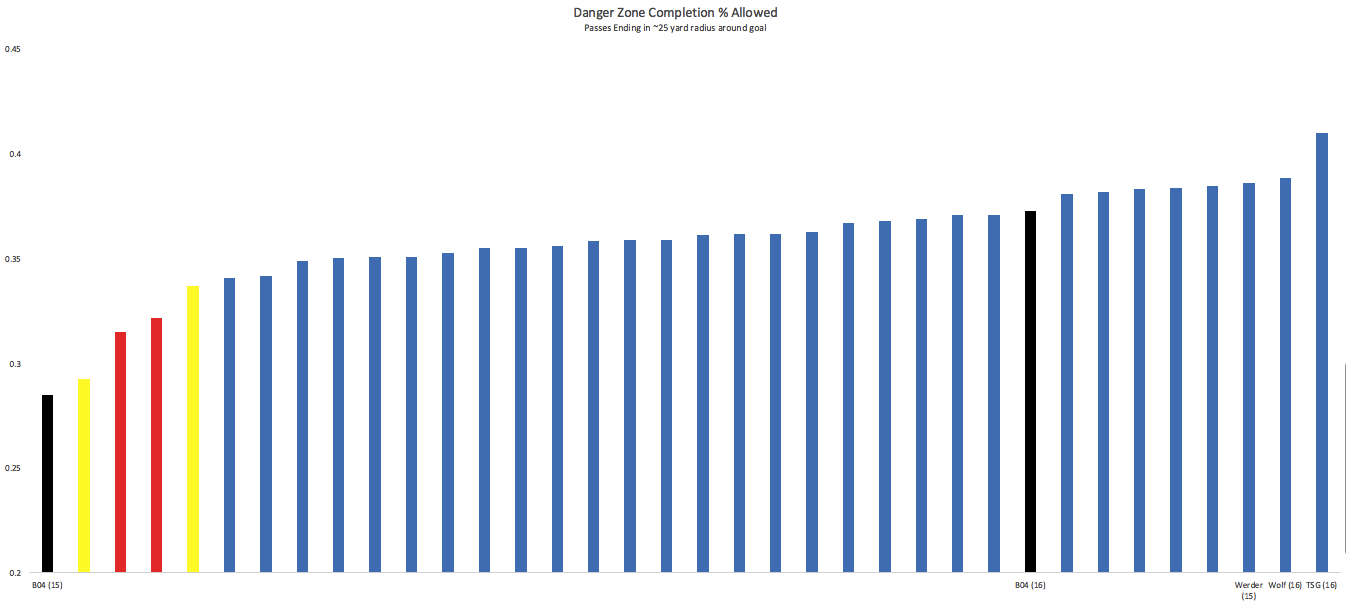 This contributed to allowing some of the easiest shots in the league on average. One place where they can point to some bad luck comes on close shots. When you combine both ends of the pitch, Leverkusen were the worst team on shots under 10 yards:
This contributed to allowing some of the easiest shots in the league on average. One place where they can point to some bad luck comes on close shots. When you combine both ends of the pitch, Leverkusen were the worst team on shots under 10 yards: 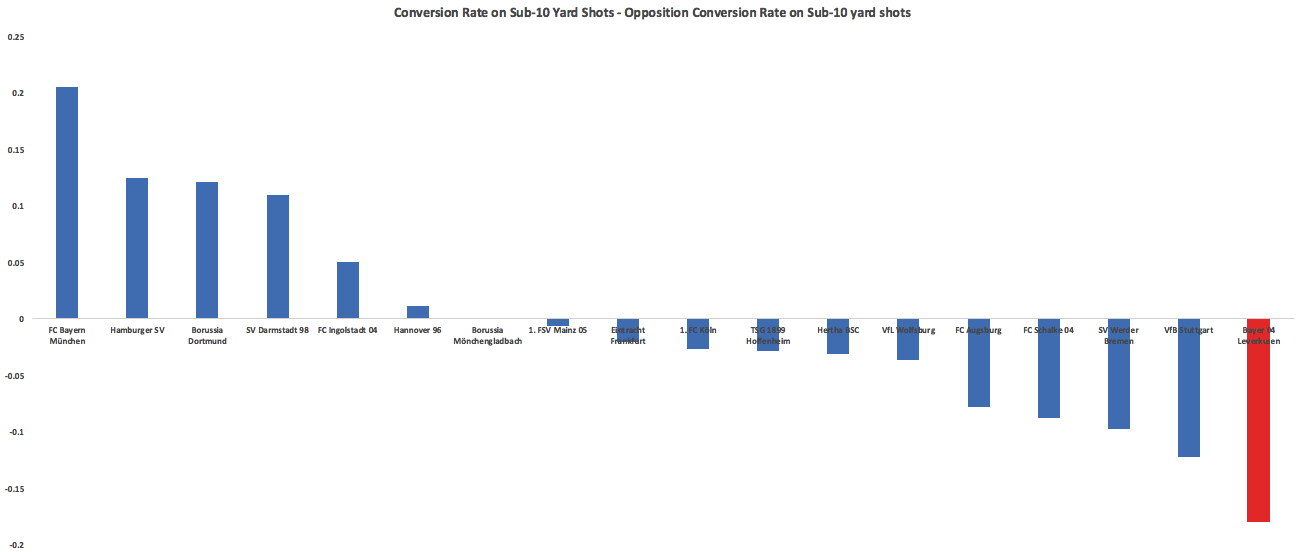 Stuttgart, the team who employed Przemysław Tytoń in goal and whose horrible short-range finishing became a well-worn source of comedy, finished ahead of Leverkusen here. The problems for Leverkusen were mainly on the defensive end, where 40% of these shots went in (league average: 26%). After the 2014-15 season if you told Leverkusen fans that Pep would leave Bayern and Dortmund would lose Gundogan, Hummels, and maybe Mkhitaryan after the 2015-16 season they would have had good reason to start dreaming of a competitive title race. After this step back, that looks like a tougher sell. You can still see a solid structure that oozes potential but you just have to squint a little more, maybe squinting really hard and having Kevin Kampl and Charles Aranguiz healthy next year will be enough to hassle the Big Two In Transition (the narrative I'm trying to gin up already). ***BONUS CONTENT*** Unsurprisingly it was Darmstadt who had the lowest ratio of completions to shots against any single opponent. Also unsurprisingly it was Stuttgart, a perfect match of fragile defending and wild pressing running up against long vertical passes. Darmstadt totaled 32 shots in the two games while only completing 255 passes, which is a lower pass total than almost every Bundesliga team averages per game. Others Who Disappointed Wolfsburg, Hoffenheim, Frankfurt Wolfsburg were cruising along at the winter break basically doing the same things as last season without the absurd conversion rates before losing some serious steam in the second half of the season. Opponents started accumulating 20% more dangerous completions and the VW club's early season numbers looked like they had just been fiddled with to give the appearance that everything was ok. The Wolves ended season with 8 points from their final 8 games while allowing more shots on target than they took (11th in league over that time period). The 2-0 win over Real Madrid means they get another year of cross-happy Hecking, who showed little flexibility in using Max Kruse and Julian Draxler this season. Most Unlucky Stuttgart For those not emotionally involved, Stuttgart’s season was simply amusing. Utterly chaotic pressing from first coach Alexander Zorniger led to them playing like Rayo Vallecano (and conceding uncontested shots like Rayo) only to pile up huge amounts of shots through their talented attackers to where their advanced numbers looked like a Champions League contender while they drifted toward the bottom of the table. Zorniger got the boot and conservative Jürgen Kramny came in to stop the chaos and quiet things down:
Stuttgart, the team who employed Przemysław Tytoń in goal and whose horrible short-range finishing became a well-worn source of comedy, finished ahead of Leverkusen here. The problems for Leverkusen were mainly on the defensive end, where 40% of these shots went in (league average: 26%). After the 2014-15 season if you told Leverkusen fans that Pep would leave Bayern and Dortmund would lose Gundogan, Hummels, and maybe Mkhitaryan after the 2015-16 season they would have had good reason to start dreaming of a competitive title race. After this step back, that looks like a tougher sell. You can still see a solid structure that oozes potential but you just have to squint a little more, maybe squinting really hard and having Kevin Kampl and Charles Aranguiz healthy next year will be enough to hassle the Big Two In Transition (the narrative I'm trying to gin up already). ***BONUS CONTENT*** Unsurprisingly it was Darmstadt who had the lowest ratio of completions to shots against any single opponent. Also unsurprisingly it was Stuttgart, a perfect match of fragile defending and wild pressing running up against long vertical passes. Darmstadt totaled 32 shots in the two games while only completing 255 passes, which is a lower pass total than almost every Bundesliga team averages per game. Others Who Disappointed Wolfsburg, Hoffenheim, Frankfurt Wolfsburg were cruising along at the winter break basically doing the same things as last season without the absurd conversion rates before losing some serious steam in the second half of the season. Opponents started accumulating 20% more dangerous completions and the VW club's early season numbers looked like they had just been fiddled with to give the appearance that everything was ok. The Wolves ended season with 8 points from their final 8 games while allowing more shots on target than they took (11th in league over that time period). The 2-0 win over Real Madrid means they get another year of cross-happy Hecking, who showed little flexibility in using Max Kruse and Julian Draxler this season. Most Unlucky Stuttgart For those not emotionally involved, Stuttgart’s season was simply amusing. Utterly chaotic pressing from first coach Alexander Zorniger led to them playing like Rayo Vallecano (and conceding uncontested shots like Rayo) only to pile up huge amounts of shots through their talented attackers to where their advanced numbers looked like a Champions League contender while they drifted toward the bottom of the table. Zorniger got the boot and conservative Jürgen Kramny came in to stop the chaos and quiet things down: 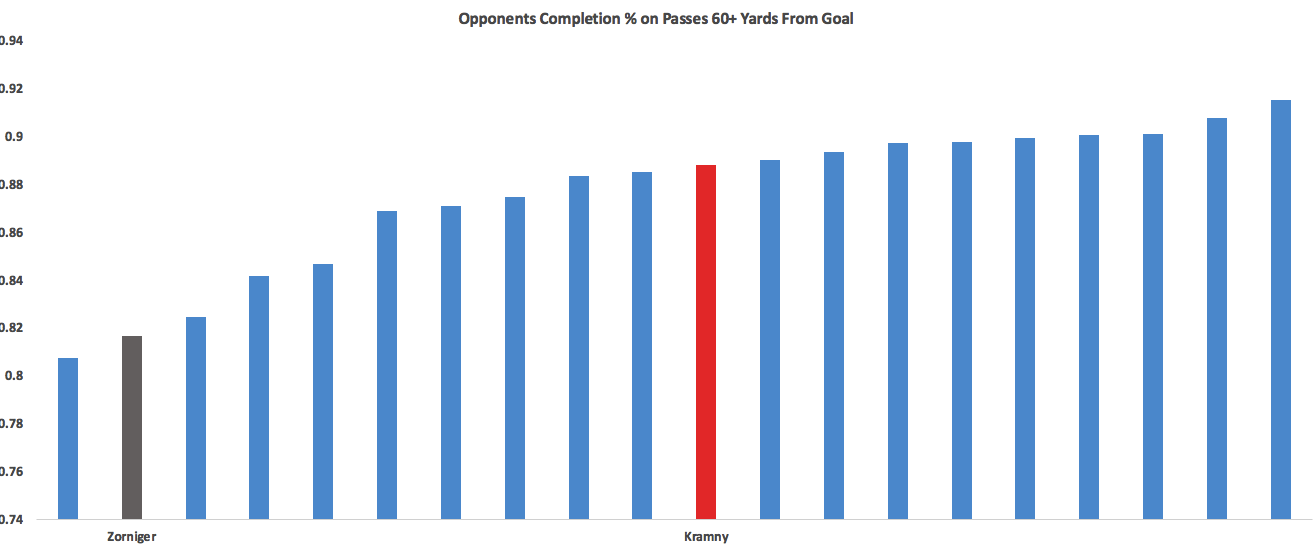 He did nothing of the sort, as Stuttgart started allowing an even higher completion % at the back. They ended the season with horrific block and SOT% allowed numbers, both worst in the league by some distance and close to 2 standard deviations below average. That’s how a team finishes 5th in TSR, 4th in Caley’s xGD and gets relegated. They allowed 22 fewer shots than Koln and yet allowed 33 more goals. Their playing style and atrocious defensive work means they never had a real chance of playing up to those lofty shot numbers, but they certainly were not a relegation level team either. Stuttgart improved their own SOT numbers 36% from last season and wound up with more on target than Leverkusen! That is usually not followed by relegation. The strange thing about Stuttgart is they are seemingly loaded with attacking talent for teams to presumably poach now. My opinion if you are trying to grab a player who will help you next season (and yes I am violating the strict rule of player talk in part 2): #1 Maxim (best passer of all, most involved, nearly tops scoring contribution list) #2 Ginczek (good at getting in-box shots off, chips in well with key passes) #3 Didavi (already off to Wolfsburg, 3.5 shots/90 led the team but showed a little too much affinity for long-range bombs with his head down. Has a strong track record) #4/#5 Harnik/Werner. Basically identical statistical profiles this season. Werner is only 20, Harnik 28. #6 Kostic. Potential is there but currently way too aggressive with the ball and just loses it too much for me to feel comfortable paying big bucks for him. Lowest volume shooter of everyone here, and still doesn’t take high-quality shots. ***BONUS CONTENT WITH THE BENEFIT OF NICELY EXEMPLIFYING TWO TEAMS ENTIRE SEASONS*** The single longest pass that led to a chance was an 85-yard bomb by who else, our old friends Darmstadt against who else, but Stuttgart. It shows off Darmstadt's ugly, vertical long bomb game, Stuttgart's relentless forward push and their generally awful defending mixed with a bit of bad luck (would have been better example if Tyton had botched the save, but good enough.) Others Wolfsburg, Werder Bremen Luckiest Hertha Berlin Hertha were both one of the more improved teams and the luckiest. They slowed the game down to an absolute crawl with the ball, taking 37 completions for every shot, a number only topped by Barcelona and PSG last season. They did this by passing backwards on average (Bayern the only other team to do this) and the average pass winding up closer to their own goal than any other team by 2 full yards.
He did nothing of the sort, as Stuttgart started allowing an even higher completion % at the back. They ended the season with horrific block and SOT% allowed numbers, both worst in the league by some distance and close to 2 standard deviations below average. That’s how a team finishes 5th in TSR, 4th in Caley’s xGD and gets relegated. They allowed 22 fewer shots than Koln and yet allowed 33 more goals. Their playing style and atrocious defensive work means they never had a real chance of playing up to those lofty shot numbers, but they certainly were not a relegation level team either. Stuttgart improved their own SOT numbers 36% from last season and wound up with more on target than Leverkusen! That is usually not followed by relegation. The strange thing about Stuttgart is they are seemingly loaded with attacking talent for teams to presumably poach now. My opinion if you are trying to grab a player who will help you next season (and yes I am violating the strict rule of player talk in part 2): #1 Maxim (best passer of all, most involved, nearly tops scoring contribution list) #2 Ginczek (good at getting in-box shots off, chips in well with key passes) #3 Didavi (already off to Wolfsburg, 3.5 shots/90 led the team but showed a little too much affinity for long-range bombs with his head down. Has a strong track record) #4/#5 Harnik/Werner. Basically identical statistical profiles this season. Werner is only 20, Harnik 28. #6 Kostic. Potential is there but currently way too aggressive with the ball and just loses it too much for me to feel comfortable paying big bucks for him. Lowest volume shooter of everyone here, and still doesn’t take high-quality shots. ***BONUS CONTENT WITH THE BENEFIT OF NICELY EXEMPLIFYING TWO TEAMS ENTIRE SEASONS*** The single longest pass that led to a chance was an 85-yard bomb by who else, our old friends Darmstadt against who else, but Stuttgart. It shows off Darmstadt's ugly, vertical long bomb game, Stuttgart's relentless forward push and their generally awful defending mixed with a bit of bad luck (would have been better example if Tyton had botched the save, but good enough.) Others Wolfsburg, Werder Bremen Luckiest Hertha Berlin Hertha were both one of the more improved teams and the luckiest. They slowed the game down to an absolute crawl with the ball, taking 37 completions for every shot, a number only topped by Barcelona and PSG last season. They did this by passing backwards on average (Bayern the only other team to do this) and the average pass winding up closer to their own goal than any other team by 2 full yards. 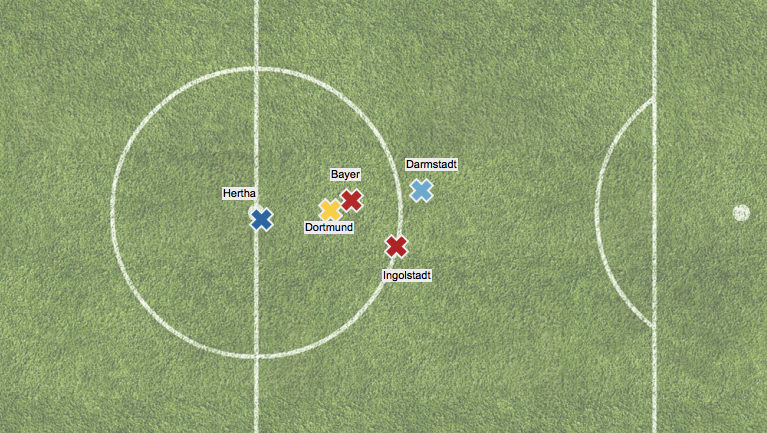
2016
The Big Bundesliga Review, Part 1: Teams
By admin
|
June 3, 2016
